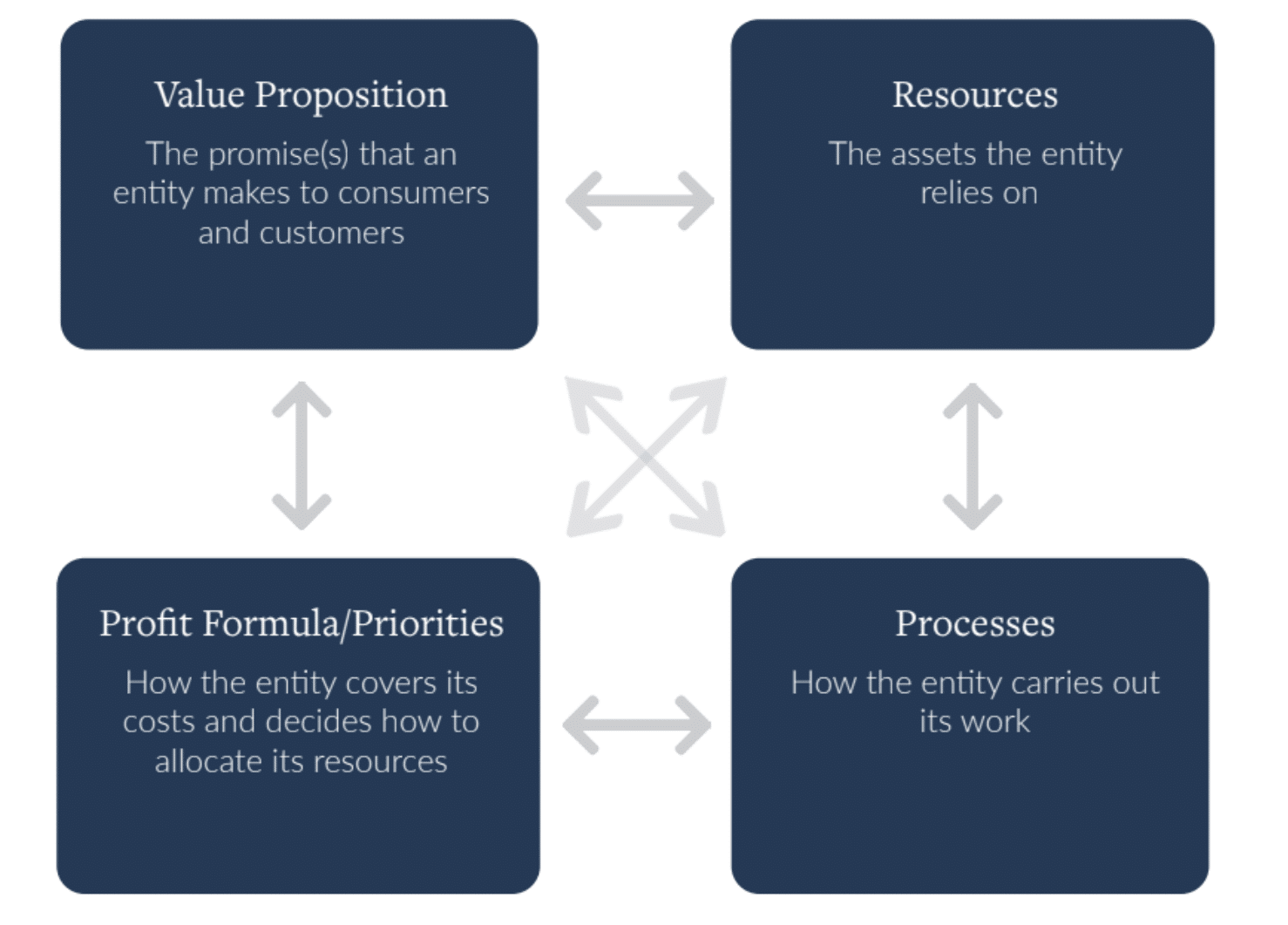In our latest report, “From child welfare to well-being: A blueprint for CBOs and government agencies,” we unveil the business models that enable prevention-oriented CBOs and prevention-enabling government agencies to enhance child and family well-being. The report highlights innovators in the field, including deep dive case studies that highlight what separates new approaches from traditional models. Specifically, we call out what it is about their business models, or operating models, that allows them to prevent children from entering or reentering the child welfare system unnecessarily. In this piece, I highlight another innovator, Strengthening Indiana Families (SIF), providing a deep dive into their approach to enhance well-being. Before highlighting what separates SIF from traditional models, I’ll provide a quick overview of Business Model Theory.
Business Model Theory overview
Business models define what organizations can and can’t do. They identify what opportunities an organization finds attractive based on the incentives of its profit formula, and what resources and processes must exist to support those opportunities. When a new opportunity, such as supporting prevention in an established child welfare model, doesn’t fit neatly into an organization’s existing business model, it almost always fails. In order for prevention efforts to succeed in established models, a business must alter the components of its business model to support this new value proposition. See Figure 1 below for a visual depiction of business model components.
Figure 1: Business Model Components

Source: This graphic was originally published by Clayton M. Christensen and Mark W. Johnson in “What Are Business Models, and How Are They Built?” Harvard Business School Module Note, August 2009 (revised November 2021). It has been modified.
Strengthening Indiana Families
SIF is an example of a prevention-oriented CBO that decreased the number of children entering foster care in Indiana by an average of 46%. The organization’s prevention-focused leader, its focus on Protective Factors, strong cross-system collaboration, and an emphasis on understanding and providing tailored responses to families’ needs enable its success.
Their prevention-focused leader, Dr. Susana Mariscal, has decades of experience in protective factors and resilience. She’s an Associate Professor at the Indiana University School of Social Work and Project Director of SIF. Dr. Mariscal worked closely with Dr. Bryan Victor, Assistant Professor at Wayne State University School of Social Work and the SIFs’ evaluator, to bring SIF to life in Indiana. This was achieved with the help of various government agencies and community partners, like Firefly Children and Family Alliance—a key implementation partner.
In addition to leadership, SIF’s processes are focused on building and strengthening Protective Factors and resilience. SIF operates Family Resource Centers (FRCs) in Indiana. The FRCs are destigmatized, one-stop-shop, family-centered spaces where SIF provides family fun events, support groups, peer recovery coaches, career counseling, enrollment help for public assistance programs, and more. Families have access to various supports in one place because community partners come to the center to provide services.
When creating the FRCs, Dr. Mariscal drew on her background and previous experiences creating programs, as well as a year-long needs assessment process. The result was a suite of offerings rooted in the stated needs and desires of the community SIF served. She and her team collected surveys from child welfare employees and conducted interviews and focus groups with families, judges, prosecutors, mental health workers, public health workers, early childhood workers, school staff, and philanthropists. She also included parents and adults who aged out of the foster care system as part of the steering committee. Using findings from this process, the team tailored the FRCs’ value propositions to match the needs in the communities they serve.
In our interview, Dr. Mariscal expressed that families are terrified of losing their children, so even if they need help, they won’t access it because they don’t want to bring attention to their families. To address this issue, Dr. Mariscal and her team wanted the FRCs to employ people who “speak the language of the community.” The FRCs are staffed with community navigators: people who know the community, know the resources available in the community, and look like and live with the people coming to the centers. Staff make families feel welcomed and showcase the activities and resources available, so if families are ever in need, they know where to go. As a result of this approach, families trust staff at the FRCs, and thus are more likely to seek their support. In our research on health care, we saw a similar trend in organizations seeking to improve health by addressing Drivers of Health: organizations that establish processes to create trust with those they serve achieve better health outcomes.
SIF’s approach pays off: from June 2019 to May 2023, the number of children entering foster care in the counties where the FRCs are located decreased by an average of 46%, with two of the counties decreasing by 70%.
SIF’s profit formula also enables its focus on prevention. The FRCs are funded by government agencies and local foundations. The Indiana Department of Child Services (IN DCS) has committed to sustaining the FRCs once the federal funding ends and provided funding to expand the FRCs to five additional counties in 2023. IN DCS, who have partnered with SIF from the beginning, decided to sustain the FRCs due to the overwhelming positive response from families, their ability to enhance community partnerships and communication across systems, and the decrease in the number of children entering foster care.
SIF is an example of how a prevention-focused leader, a strong community collaboration, dedication to building families’ Protective Factors, and understanding families can improve child and family well-being. These are critical business model components to consider for organizations seeking similar outcomes.
Are you a CBO or government agency that wants to incorporate prevention into your business model? Or are you a philanthropist or child welfare expert dedicated to improving child well-being outcomes? Check out our latest report, which provides a blueprint for how CBOs and government agencies that want to support prevention can set up their business models to succeed.


